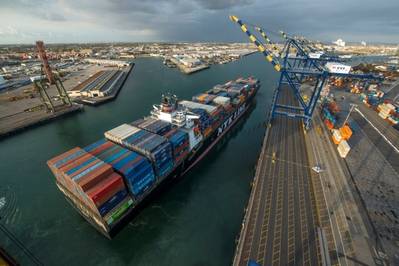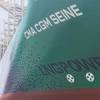Project will enhance wharf, rail and yard infrastructure to optimize terminal operations
The Port of Los Angeles will begin construction this summer on a two-year project to improve the marine container terminal operated by Yusen Terminals LLC. The Los Angeles Board of Harbor Commissioners has awarded Manson Construction Co. a $44.6 million contract to upgrade berths, and backlands at Berths 212-224.
“This project consists of strategic improvements to make Yusen a more agile terminal and strengthen our competitive edge,” said Port Executive Director Gene Seroka. “In addition to making the best use of Port property, it incorporates green features and practices that further our commitment to the highest environmental standards.”
“Yusen is pleased to work with the Port of Los Angeles to improve our wharf and terminal,” said Alan McCorkle, Vice President of West Coast Operations for NYK Ports comprised of Yusen Terminals LLC and Ceres Terminals Inc., sister companies jointly owned by Nippon Yusen Kabushiki Kaisha (NYK Group) and Macquarie Infrastructure Partners III. “This project will allow Yusen to handle vessels and move cargo more efficiently for our customers.”
Based on all design, project management and construction costs, the Port’s total investment is estimated at more than $67 million. This amount includes cost for an on-dock rail project which will be done under a separate contract in 2016. Additionally, Yusen estimates it could invest more than $60 million in support of the project. About $8 million of the Port’s costs will be paid by California Proposition 1B Transportation Bond funds.
Yusen operates the 185-acre container terminal under a long-term lease with the Port that extends through 2026. The project is part of the Port’s larger capital program aimed at enhancing berth, gate and rail efficiencies at all Los Angeles marine terminals. Over the next five years, the Port plans to invest more than $800 million in its facilities.
The project consists of upgrading wharf, and backland infrastructure within the terminal’s existing footprint to enhance Yusen’s ability to service the biggest ships in the trans-Pacific trade lanes. The improvements will allow Yusen to simultaneously work three container ships carrying up to 13,000, 11,000 and 6,500 Twenty-Foot Equivalent Units (TEUs) respectively and ensure cargo flows during peak periods when ships call at all three berths.
To date, the largest ship that has called at Yusen is an 8,500-TEU vessel. The terminal typically receives 6,500-TEU ships and works two vessels concurrently.
Major project elements include:
- Deepening Berths 214-216 from -45 to -53 feet and Berths 217-220 from -45 to 47 feet.
- Adding up to four new ship-to-shore gantry cranes and raising some existing cranes to equip the terminal with up to 14 operating Post-Panamax cranes, including eight Super Post-Panamax cranes with a maximum outreach of 197 feet or 22 container rows across.
- Extending the wharf crane rail infrastructure that supports lateral repositioning of ship-to-shore cranes by adding 1,500 feet of crane rail at Berths 217-220.
- Adding four new alternative maritime power (AMP) boxes at Berths 217-220 to provide shore to ship electrical connection facilities.
- Increasing Yusen’s on-dock rail capacity 25 percent by adding a single 2900-foot line of loading track to accommodate higher container volumes in a short period of time when large ships call.
The project incorporates 25 measures to mitigate environmental impacts during construction and ongoing terminal operations. They include using the cleanest construction equipment, implementing noise reduction strategies and recycling building materials for use on-site or other construction projects. Green practices include:
- By Jan. 1, 2017, 95 percent of the ships calling at the terminal will comply with the Port’s expanding Vessel Speed Reduction Program and slow to 12 knots with 40 nautical miles of Point Fermin.
- By 2026, NYK-operated ships calling at the terminal must run on shore power for 95 percent of the time they are at berth.
- Independent energy audits will be done every five years and energy-saving technology will be used wherever possible throughout the facility.
The construction project is expected to generate about 592 jobs during construction and eventually add more than 2,200 permanent direct and indirect jobs to the Southern California economy through 2026. More than 13 percent of Manson’s subcontractors and suppliers are small or very small business enterprise (SBE/VSBE) companies. Construction will be done under a project labor agreement that facilities timely project completion, ensures fair wages are paid and promotes use of local labor.







